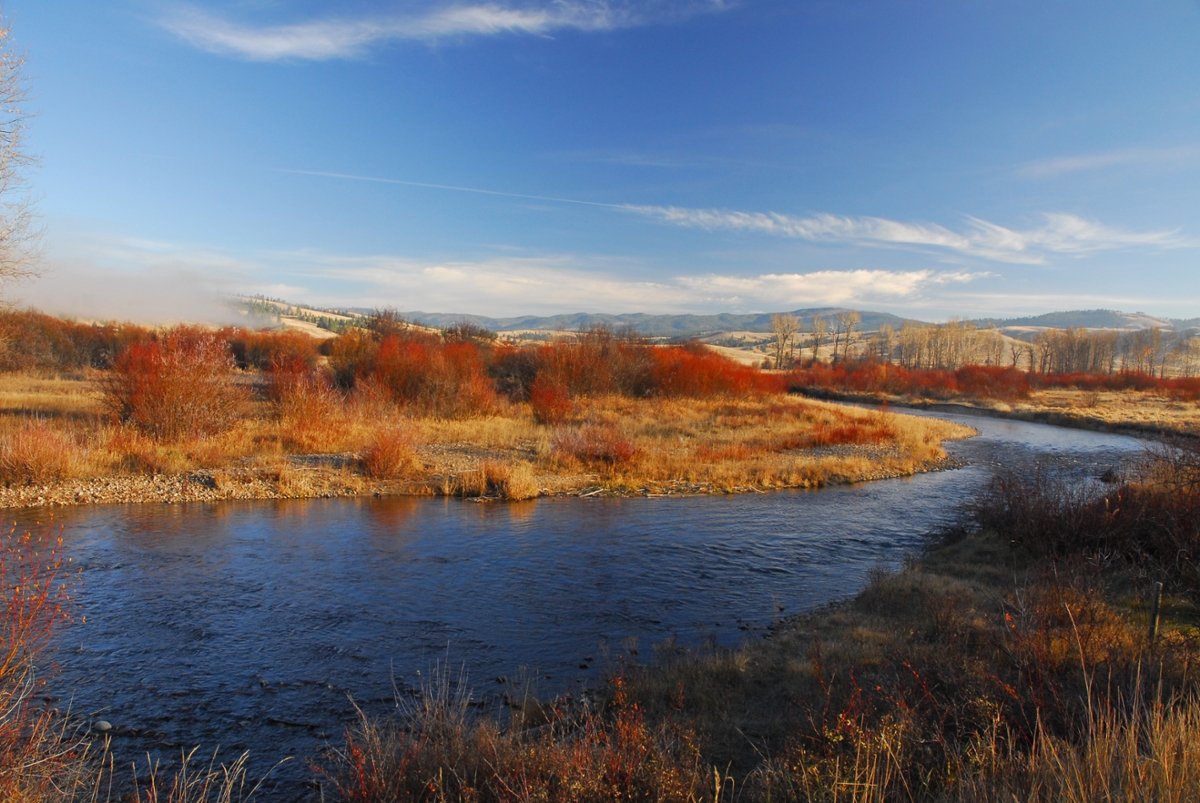The Salish and Corps of Discovery Meet at Ross's Hole
 Ross’s Hole in the Upper Bitterroot (Photo by Rick and Susie Graetz)
Ross’s Hole in the Upper Bitterroot (Photo by Rick and Susie Graetz)
A quiet place now but once used by generations of indigenous peoples, Ross’s Hole, on the Lewis and Clark National Historic Trail sprawls out from the junction of Camp Creek and the East Fork of the Bitterroot River. A well-marked site, it is just off U.S. Highway 93 near Sula, Montana.
The place was named for fur trader Alexander Ross, leader of a Hudson Bay Company trapping brigade, who camped here in March 1824. Historic records detail that with him were 55 Indian and white trappers, 89 women and children and 392 horses. En route from Spokane House to Snake River country, the party spent almost a month here trying to break through deep snow encountered in the mountain passes leading to the Big Hole Valley. Ross called the basin “The Valley of Troubles” – probably owing to their difficulties.
The Corps of Discovery Connection
On Aug. 30, 1805, leaving the Lemhi River country, the Corps bade farewell to Sacagawea’s people. Following a Shoshone guide, Old Toby, the Corps set out northward and headed for the Indian road that they had been told would lead them across the Bitterroot Mountains – today’s U.S. Highway 12 to Lolo Pass.
Seeking the shortest way over the Bitterroot divide, they labored up the head of the North Fork of the Salmon River, instead of following the more circuitous Indian road that wound back over the Continental Divide to the east. Heavy timber, dense brush, snow, rain and steep rocky slopes made the going extremely arduous. There are no obvious natural routes, and the journal description is vague with details that may be erroneous.
On the morning of Sept. 4, they began their trek down the north slope of the Bitterroot Divide, staying just above today’s Camp Creek. Their goal was to intersect with the Indian road that would carry them down the valley of today’s Bitterroot River, but which they dubbed “Clark’s River.” If they had spied that drainage from the highest point on the ridge that bounded it, their destination for the day was about 10 miles and 3,400 vertical feet away – an exhausting descent of 340 feet per mile.
Toward evening they arrived at a small, flat, grassy valley ringed by mountains – a rond or “hole,” as trappers would call it – and encountered a large encampment of Salish Indians. Sgt. Ordway noted in his journal that there were about 400 people, 40 lodges and four or five hundred horses.
The Salish Connection
The following was taken in part from an interpretive sign at the site.
Three Eagles, father of Chief Victor and grandfather of Chief Charlo, was just leaving camp to scout the area, fearing there might be some enemies around – usually Blackfeet – intending to steal horses, as was done then very frequently. They saw at a distance a party of over 20 men, with two men on horses in front and many men walking and leading packhorses. Three Eagles saw that they were not a war party, as they were traveling slowly with no effort at concealment.
Seeing that these men wore no blankets, the old chief did not know what to think at first. Upon their arrival, the chief gave orders to bring the best robes for Capt. Meriwether Lewis and Capt. William Clark to sit on, and one for each man to use as a blanket.
In his journal, Clark summarized his impression of the Salish:
“Those people received us friendly, threw white robes over our shoulders and smoked in the pipes of peace, we encamped with them and found them friendly but nothing but berries to eat a part of which they gave us, those Indians are well dressed with skin shirts and robes, they stout and light complicated more so than common for Indians. The Chiefs harangued until late at night, smoked our pipe and appeared satisfied. I was the first white man whoever were on the waters of this river.”
Immediately the Americans took a genuine liking to the Salish, who responded in kind. “They are the likeliest and honest we have seen and are very friendly to us,” wrote Sgt. Ordway, “and appeared to wish to help us as much as lay in their power.”
Two days were spent camped with the Salish. The captains erroneously called them the Flatheads. On the return trek from the Pacific, the Clark contingent stopped here on the nights of July 5-6, 1806.
Rick and Susie Graetz | Department of Geography | University of MontanaHistorical notes courtesy of: The Montana Department of Transportation, The U.S. Forest Service, The Lewis and Clark National Historic Trail
